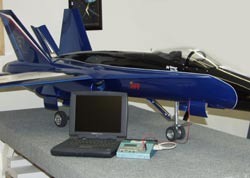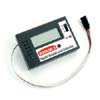|
Spring is coming! Soon, a beautiful spring day will arrive, and you'll
want to go out flying. To make sure you have an enjoyable and successful
opening day, now is the time to prepare. Here are a few things you should
thoroughly check to make sure your plane is ready and safe to fly.
 |
| Batteries being cycled with an Orbit
Charger and a R.S. 232 output to a laptop computer. |
Batteries: You should test your batteries under load. Hangar 9's
Digital Variable Load Voltmeter (HAN171) is perfect for this. You can
also use a charger that measures the capacity of your battery pack (number
of milliamp hours). If the battery pack is not up to its rated capacity,
you should replace it. Be sure to check your transmitter's batteries too.
Fuel Lines: Make sure your fuel lines are in good condition. Be
sure to inspect the clunk lines and clunk in the fuel tank. This is where
most failures occur. While you have the fuel tank out of the plane, check
it for worn spots due to vibrations. This is also a good time to flush
out any oil that may have accumulated in the fuel lines.
Engine: Check all of the engine-mount bolts and the muffler bolts.
Be sure the bolts are tight and replace any that are missing. This is
also a good time to replace the glow plug. If you fly a gas plane, flush
out any oil that may have accumulated in the carburetor. This is done
by removing the diaphragm cover and depressing the diaphragm lever, while
the fuel tank is under slight pressure.
Linkages: Inspect all linkages. Check all the control horns for
excessive wear. A worn-out control horn could result in flutter or even
cause loss of control in flight. Check all the solder joints, ball links,
cables and hinges. All the connections should be tight, and the control
surface should move freely.
 |
| Hangar 9 Digital Variable Load Voltmeter
(HAN171) |
Radio and Servos: Check all the wires and connectors for wear.
Look for holes or cuts in the insulation due to vibrations. Be sure all
connections are secure. Replace any defective wiring, switch assemblies
and tie wraps. Tape your crystal into your receiver by wrapping the receiver
with electrical tape over the crystal. Check the condition of the foam
used to protect your receiver.
Don't forget to check your antenna wire. Antenna wires typically take
a lot of abuse and could be damaged. Also, check your servos for smooth,
full-range operation. There should be no glitching or erratic movement.
If you own a JR® 10X transmitter, you can easily test the operation
of your servos using the "Function Mode 75" servo monitor feature.
Be sure to disconnect the servo arms from the servos first, as the servo
monitor feature will test the full range of motion of all the servos and
could damage a linkage. If you are using metal gear servos, use a drop
of blue Locktite on the servo control horn screw. Once you're happy with
the servo performance, be sure to range check the radio before you take
that first flight.
Landing Gear: There are many kinds of landing gear, from fixed
gear tail draggers to full-scale models with retractable systems and brakes.
But they all need to be checked to ensure all nuts and bolts are tight,
and all the components are in good condition. Don't forget to add a drop
of retract oil to the air tank of your retracts. Also, be sure to apply
a small amount of grease to the axles and brakes.
Note: Now that your plane is ready to go, you may want to spend
a little extra time sprucing it up. Inspect the covering and work out
any wrinkles that you find. Clean off the excess oil and touch up the
paint. If you feel uncomfortable about performing any of these steps,
don't be afraid to ask an experienced pilot at your local flying field
or hobby shop for help.
|